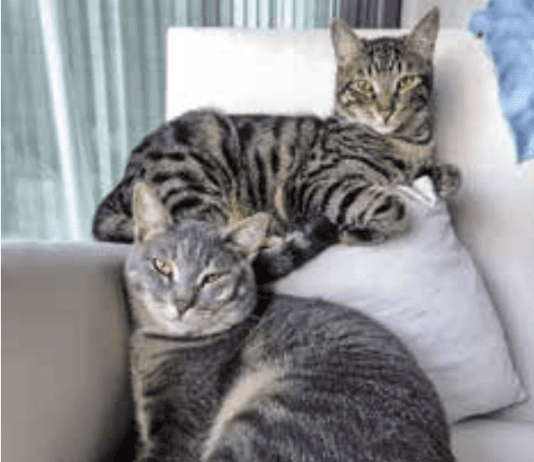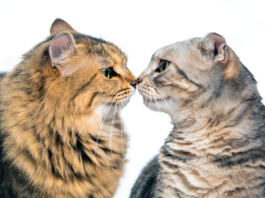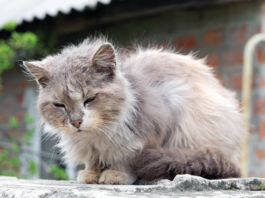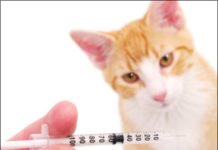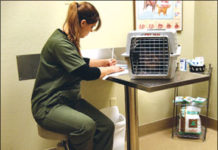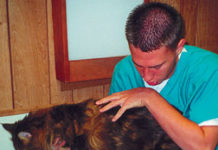Should She Adopt a Sweet Stray Whos Been Diagnosed With FIV?
Recently, a stray cat appeared on my porch, and he is the sweetest thing. I would like to adopt him and bring him into our house, but when I brought him to the veterinarian, he tested positive for Feline Immunodeficiency Virus (FIV). I am concerned because I have two other indoor cats. Can you provide some advice about how to proceed?
Ask Elizabeth: July 2012
Dear Elizabeth: We adopted a new kitten from a local rescue group last month, and she is just perfect. Although she had been tested for the leukemia virus and FIV by the terrific group that saved her from the street, we took her to our veterinarian right away so that she could be examined before we introduced her to our two older cats. After a clean bill of health, we brought Bunny home, and she has become part of the family. The problem is that before we scheduled her spay surgery, she came into heat. What a scene!
Short Takes: December 2011
Unfortunately, feline lower urinary tract diseases (FLUTDs) are common. Urethral obstruction (UO) is believed to occur more commonly in young cats and almost exclusively in male cats, although veterinary literature has limited information regarding the risk factors for UO. The most common etiology of UO in cats is urethral plugs, and the most common signs of UO include stranguria, dysuria and pain, and varying degrees of systemic signs.
Panleukopenia: A Lethal Threat
Among all agents of feline illness and mortality, few if any are more pernicious — especially to kittens — than feline panleukopenia virus (FPV). The disease is also known in some circles as “distemper,” a misnomer, notes Fred Scott, DVM, PhD, a professor emeritus of virology in Cornell University’s College of Veterinary Medicine and founding director of the Cornell Feline Health Center. ”Distemper” refers to a respiratory disease, and there is no respiratory component to feline panleukopenia. Cats become infected with FPV — which is classified as a parvovirus — by living in an environment that is contaminated with it or by coming in contact with the urine, feces, saliva or nasal secretions of a cat that is already infected.
FeLV and FIV Testing: Important
Among all causes of lethal feline disease, none should be taken more seriously by cat owners than those caused by two specific submicroscopic organisms: feline leukemia virus (FeLV) and feline immunodeficiency virus (FIV). Although these viruses are somewhat different in appearance and in the manner in which they exact their toll on feline health, infection with either one of them, if undetected, is capable of causing a cats premature death. All Too Common. To make matters worse, FeLV and FIV infections are by no means rare. Recent estimates indicate that two percent to four percent of the 83 million or so cats in the U.S. harbor one or both of these two viruses.
Short Takes: 09/09
Governor Linda Lingle, accompanied by State Civil Defense Director, Major General Robert Lee, highlighted the importance of emergency preparedness by showcasing Hawaiis ongoing emergency shelter programs for people with special health needs and pet-friendly shelters. State Civil Defense, working with the State Department of Education, county civil defense agencies, American Red Cross, Department of Health, Hawaiian Humane Society and other public and private sector partners, has designated 158 facilities statewide that may serve as Special Health Needs shelters, and another 55 facilities that may be used as Pet-Friendly shelters. These shelters are located in separate rooms or buildings on public school campuses where general population emergency shelters are also located.
Testing for FIV and FeLV
Among all causes of lethal feline disease, none should be taken more seriously by cat owners than those caused by two specific submicroscopic organisms: feline leukemia virus (FeLV) and feline immunodeficiency virus (FIV). Although these viruses are somewhat different in appearance and in the manner in which they exact their toll on feline health, infection with either one of them, if undetected, is capable of causing a cats premature death. To make matters worse, FeLV and FIV infections are by no means rare. Recent estimates indicate that two percent to four percent of the 83 million or so cats in the U.S. harbor one or both of these two viruses.
An FIV Primer
Its a major health risk for the outdoor cat, so owners need to have their cats tested for feline immunodeficiency virus.
Has Your Cats Behavior Changed?
Losing weight and sleeping more than usual can be subtle signs of illness.
Caring for the Cat With Chronic Illness
Would you be able to provide at-home care for your cat? Heres what to consider.
Ask Dr. Richards: 02/04
Question: About two weeks ago our 17-year-old cat, Goldie, went blind (at least thats when we first noticed her bumping into things). Our veterinarian...
On the Lookout for FIV
Owners are urged to have their cats tested for feline immunodeficiency virus.

